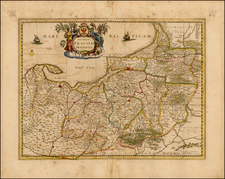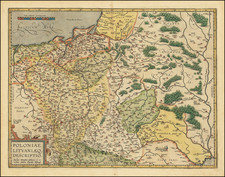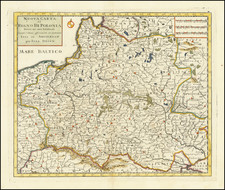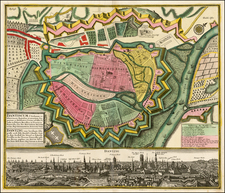Fine old color example of this rare separately published map of Poland, signed by Jodocus Hondius.
Guenter Schilder noted that it cannot be determined with certainty whether this map should be attributed to Jodocus Hondius Sr. or his son Jodocus Jr. The engraving style places this map very probably in the group of folio-sized maps with decorative borders first published by Jodocus Hondius Sr. in 1606/07."
Incluedes decorative borders surround the map. The top and bottom borders are occupied by town views in oval frames, while the side borders consist of three costumed figures each. Top border: Dantzick, Cracovia, Breslaw. Bottom border: Posnania, Sandomiria, Crosno, Biecz. Side borders: Costumed figures.
Jodocus Hondius the Elder (1563-1612), or Joost de Hondt, was one of the most prominent geographers and engravers of his time. His work did much to establish Amsterdam as the center of cartographic publishing in the seventeenth century. Born in Wakken but raised in Ghent, the young Jodocus worked as an engraver, instrument maker, and globe maker.
Hondius moved to London in 1584, fleeing religious persecution in Flanders. There, he worked for Richard Hakluyt and Edward Wright, among others. Hondius also engraved the globe gores for Emery Molyneux’s pair of globes in 1592; Wright plotted the coastlines. His engraving and nautical painting skills introduced him to an elite group of geographic knowledge seekers and producers, including the navigators Drake, Thomas Cavendish, and Walter Raleigh, as well as engravers like Theodor De Bry and Augustine Ryther. This network gave Hondius access to manuscript charts and descriptions which he then translated into engraved maps.
In 1593 Hondius returned to Amsterdam, where he lived for the rest of his life. Hondius worked in partnership with Cornelis Claesz, a publisher, and maintained his ties to contacts in Europe and England. For example, from 1605 to 1610, Hondius engraved the plates for John Speed’s Theatre of the Empire of Great Britaine.
One of Hondius’ most successful commercial ventures was the reprinting of Mercator’s atlas. When he acquired the Mercator plates, he added 36 maps, many engraved by him, and released the atlas under Mercator’s name, helping to solidify Mercator’s reputation posthumously. Hondius died in 1612, at only 48 years of age, after which time his son of the same name and another son, Henricus, took over the business, including the reissuing of the Mercator atlas. After 1633, Hondius the Elder’s son-in-law, Johannes Janssonius, was also listed as a co-publisher for the atlas.









![[Poland] Mappa Geographica Poloniae, in partes suas majores, Austriae, Russie et Borussie. divisa in lucem pubicam . . . .](https://storage.googleapis.com/raremaps/img/small/60050.jpg)


![[ Eastern Poland ] Der Koniglichen Republik Polen Woiwodschaften Podlachien mit dem obern Theileder Woiwodschafter Lublin, oder Klein Polens…](https://storage.googleapis.com/raremaps/img/small/102985.jpg)

